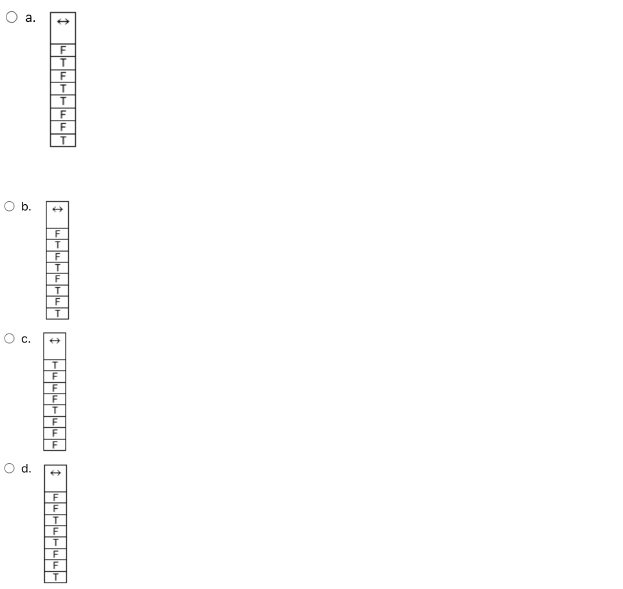Let p, q and r be simple declarative statements. Which alternative provides the truth values for the biconditional '' of the compound statement provided in the given table? Hint: Determine the truth values of pr, qvr, (pr) ^ (qvr), q→p, (q→ p) and (q→ p) ^ r in separate columns before determining the truth values of [(pr) ^ (qvr}] → [(q→ p) ^r]. pqr [(p→r) ^ (q V r)] ↔ [2(9 →P) ^] T T T T T F T F T T F F F T T F T F F F T = F F F
Let p, q and r be simple declarative statements. Which alternative provides the truth values for the biconditional '' of the compound statement provided in the given table? Hint: Determine the truth values of pr, qvr, (pr) ^ (qvr), q→p, (q→ p) and (q→ p) ^ r in separate columns before determining the truth values of [(pr) ^ (qvr}] → [(q→ p) ^r]. pqr [(p→r) ^ (q V r)] ↔ [2(9 →P) ^] T T T T T F T F T T F F F T T F T F F F T = F F F
Algebra & Trigonometry with Analytic Geometry
13th Edition
ISBN:9781133382119
Author:Swokowski
Publisher:Swokowski
Chapter10: Sequences, Series, And Probability
Section10.5: The Binomial Theorem
Problem 17E
Related questions
Question

Transcribed Image Text:o a.
O b.
o c.
O d.
I
----
I ----
-ר-ר-ר-
t
----
דד -||-||-|
![Let p, q and r be simple declarative statements. Which alternative provides the truth values for the biconditional '' of the compound
statement provided in the given table?
Hint: Determine the truth values of pr, qvr, (pr) ^ (q vr), q→ P, (q→p) and (q→ p) ^ r in separate columns before
determining the truth values of [(pr) ^ (q vr}] → [(q→p) ^r].
pqr [(pr) ^ (q V r)] → [(q→P) ^]
T T
F
T
F
T
T
T F
T
FFF
T
T
T
T
F
F
F
F](/v2/_next/image?url=https%3A%2F%2Fcontent.bartleby.com%2Fqna-images%2Fquestion%2Fabdd1821-d7b6-4171-a67e-edf70418727b%2F2e7caf16-95e2-4957-af86-b98077a4773d%2Fsmqkww6_processed.png&w=3840&q=75)
Transcribed Image Text:Let p, q and r be simple declarative statements. Which alternative provides the truth values for the biconditional '' of the compound
statement provided in the given table?
Hint: Determine the truth values of pr, qvr, (pr) ^ (q vr), q→ P, (q→p) and (q→ p) ^ r in separate columns before
determining the truth values of [(pr) ^ (q vr}] → [(q→p) ^r].
pqr [(pr) ^ (q V r)] → [(q→P) ^]
T T
F
T
F
T
T
T F
T
FFF
T
T
T
T
F
F
F
F
Expert Solution
This question has been solved!
Explore an expertly crafted, step-by-step solution for a thorough understanding of key concepts.
Step by step
Solved in 2 steps with 2 images

Recommended textbooks for you

Algebra & Trigonometry with Analytic Geometry
Algebra
ISBN:
9781133382119
Author:
Swokowski
Publisher:
Cengage

Algebra & Trigonometry with Analytic Geometry
Algebra
ISBN:
9781133382119
Author:
Swokowski
Publisher:
Cengage